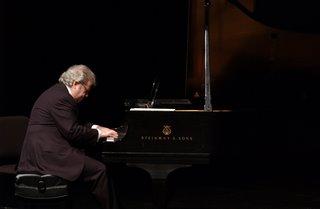Mixed Bag from Ax-Morlot in Baltimore
 Ludovic Morlot stepped in for Yuri Temirkanov during the Baltimore Symphony Orchestra’s run of concerts this week. With him came a different opening of the concert: Instead of the Armenian Suite by the Philadelphia native Richard Yardumian we were served a smart but slightly glib Manfred Overture of Schumann’s. With this orchestral warm-up based on Lord Byron poetic drama out of the way, Poland-born Canadian Emanuel Ax came on stage with the main attraction, Mozart’s “Jeunehomme” Concerto no.9, K 271 in E-flat major. Unprecedented in length and style up to that point, it marks Mozart’s ascension to true genius for musicians and Mozart biographers alike. Alfred Brendel likened it to a world wonder from which on “the Mozart player must shoulder a burden of perfection that goes beyond his powers” (“A Mozart Player Gives Himself Advice”, 1985), Alfred Einstein to Beethoven’s Eroica.
Ludovic Morlot stepped in for Yuri Temirkanov during the Baltimore Symphony Orchestra’s run of concerts this week. With him came a different opening of the concert: Instead of the Armenian Suite by the Philadelphia native Richard Yardumian we were served a smart but slightly glib Manfred Overture of Schumann’s. With this orchestral warm-up based on Lord Byron poetic drama out of the way, Poland-born Canadian Emanuel Ax came on stage with the main attraction, Mozart’s “Jeunehomme” Concerto no.9, K 271 in E-flat major. Unprecedented in length and style up to that point, it marks Mozart’s ascension to true genius for musicians and Mozart biographers alike. Alfred Brendel likened it to a world wonder from which on “the Mozart player must shoulder a burden of perfection that goes beyond his powers” (“A Mozart Player Gives Himself Advice”, 1985), Alfred Einstein to Beethoven’s Eroica.
Gail Wein, Baltimore Symphony Orchestra (Washington Post, March 20) Tim Smith, BSO, Morlot both fill the void with fire and energy (Baltimore Sun, March 18) Jens F. Laurson, Putting it on Ax (Baltimore City Paper, March 29) |
 Pétrouchka falls between Stravinsky’s Firebird and Le Sacre du Printemps not only by date of composition but also style. If it is mostly Firebird (and enough so to delight the audience at its 1911 premiere in Paris), you can hear Le Sacre waiting in the wings all too clearly. The audience at the latter’s premiere may have rioted, but it’s not like they had not been warned. No fear of any rioting with the tame and sparse Meyerhoff audience – not even in such an extraordinarily terse, driven and tight performance of the 1947 Pétrouchka (modified by Stravinsky to renew copyrights and secure a continued stream of revenue, toning down the demands on the size of the orchestra in the process) such as Morlot’s. Edging the orchestra on with his precise stick (what a difference to the shapeless, emotive waves of Temirkanov) and energetic cues, he got a technical ferocity out of the band but not much emotion or passion (which is where Temirkanov’s hand-flopping signals are far more effective.)
Pétrouchka falls between Stravinsky’s Firebird and Le Sacre du Printemps not only by date of composition but also style. If it is mostly Firebird (and enough so to delight the audience at its 1911 premiere in Paris), you can hear Le Sacre waiting in the wings all too clearly. The audience at the latter’s premiere may have rioted, but it’s not like they had not been warned. No fear of any rioting with the tame and sparse Meyerhoff audience – not even in such an extraordinarily terse, driven and tight performance of the 1947 Pétrouchka (modified by Stravinsky to renew copyrights and secure a continued stream of revenue, toning down the demands on the size of the orchestra in the process) such as Morlot’s. Edging the orchestra on with his precise stick (what a difference to the shapeless, emotive waves of Temirkanov) and energetic cues, he got a technical ferocity out of the band but not much emotion or passion (which is where Temirkanov’s hand-flopping signals are far more effective.) The story is as tumultuous as the score sounds. Mean and ugly little Pétrouchka covets the lithe Ballerina, but the Ballerina only flees before his advances. Could it be because “Pétrouchka is” – according to Janet E. Bedell’s liner notes – “better endowed than the others…”? Maybe the puppets are truer to life than I thought… but one wonders why the Ballerina consequently turns to the glamorous and exotic Moor. Being enamoured by the latter is obviously enough to get any misanthropic puppet’s blood boiling (especially since the Moor is an evil fool, to boot) and Pétrouchka won’t have it. But as the puppets flee the theatre, the moor decapitates Pétrouchka, leaving his evil spirit to haunt the disconcerted puppet master from above the theater tent. All expressed in music. Morlot betrayed potential in this performance, but sparks did not fly. Still, we’ll likely hear more of him in the near future.
P.S. Ax even writes a "blog" - only that it isn't a blog and that he probably doesn't write it himself. Well, maybe he does, it's short enough: He muses "On Applause" (a topic Alex Ross took on last year) and states the usual wishes, missing the root of the problem. We'll get to chime in on that, sooner or later; meanwhile opinions and suggestions on that topic sent to Charles or myself are welcome.




















































